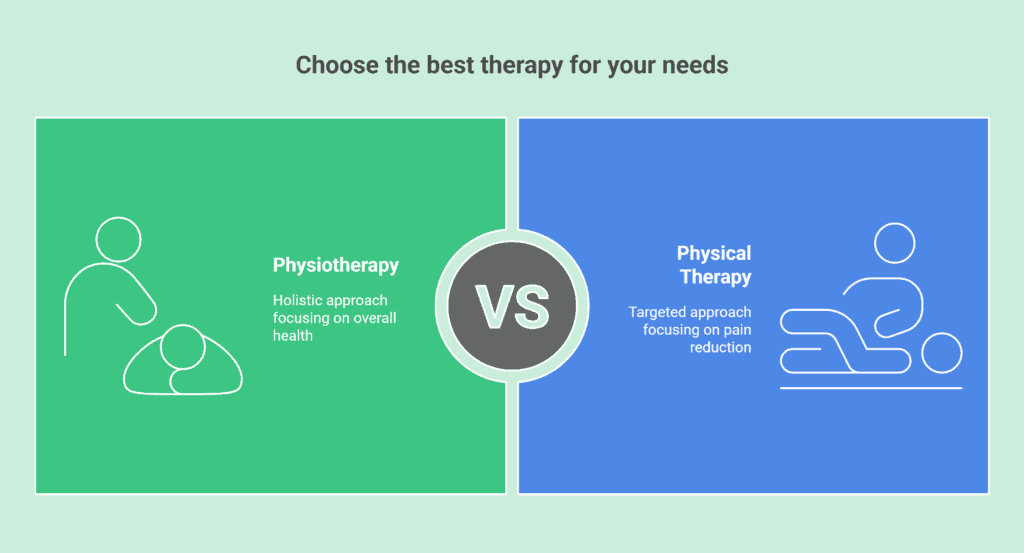Table of Contents
Main Takeaways
- Understand the core difference: Physiotherapy takes a holistic, lifestyle-focused approach to healing, while physical therapy concentrates more on exercise and specific physical interventions.
- Physiotherapy offers broader treatment options: With specialisations like musculoskeletal, neurological, and sports physiotherapy, it addresses both symptoms and root causes using varied techniques from manual therapy to electrotherapy.
- Physical therapy is more exercise-based: It focuses on restoring movement and managing pain through targeted exercises and common modalities such as ultrasound, heat, and cold therapy.
- Professional qualifications matter: UK physiotherapists are HCPC-registered and often hold advanced training, making them qualified to assess and treat a wide range of conditions across all age groups.
- Choosing the right care starts with expert advice: Booking an assessment with a qualified physiotherapist, like those at One Body LDN, ensures a tailored treatment plan that fits your condition—whether it requires physiotherapy or physical therapy.
In our latest article, we are comparing physiotherapy versus physical therapy. While these terms may seem interchangeable, there are actually some key distinctions. Which one you choose can significantly impact your treatment journey. Whether you’re recovering from an injury, managing chronic pain, or just want to enhance your overall well-being, understanding these differences is crucial.
Our therapists will help you explore the unique approaches, techniques, and benefits of each discipline in this article. By the end, you’ll have a clear understanding of which practice is best for your needs and goals. Let’s get started!
Quick Answer – Physiotherapy vs Physical Therapy

Too busy to read a full guide? Here’s what you need to know:
- Physiotherapy focuses on treating conditions and injuries through a holistic approach, incorporating techniques like massage and joint manipulation. It aims to restore function and promote overall health and well-being.
- Physical therapy, on the other hand, primarily targets pain reduction and mobility improvement through exercise plans and modalities like ultrasound and hot/cold therapies.
The main difference lies in their approach and goals: physiotherapy takes a holistic view of the patient’s health, considering lifestyle and overall well-being, while physical therapy focuses more on targeted exercises and modalities to address specific physical issues. So, if you’re seeking a comprehensive treatment addressing both physical and lifestyle factors, physiotherapy may be your best bet. However, if you’re looking for focused exercises to improve mobility and manage pain, physical therapy might be the route for you.
If physical therapy is unsuited to your particular condition or goal, then physiotherapy is often the answer – it has a much wider scope, and physiotherapists attain further education for in-depth specialisations.
What makes the matter more confusing is that licensed physiotherapists often practice physical therapy – more on that below.
Physiotherapy

Physiotherapy covers a broad range of treatments aimed at restoring and maintaining physical function and mobility. One of the primary goals of physiotherapy is to alleviate pain, improve movement, and enhance overall quality of life. Basically, physiotherapy wants to restore normal functioning and even improve it!
This type of therapy uses various modalities and techniques, including manual therapy techniques (such as joint mobilisation and soft tissue massage), exercise prescription, electrotherapy (such as ultrasound or TENS), hydrotherapy, and acupuncture. These modalities are designed to address immediate symptoms and underlying causes to facilitate optimal recovery and function.
Your physiotherapist will choose the most appropriate modalities based on your condition and the type of physio you are receiving. Common types of physiotherapy include:
- Musculoskeletal Physiotherapy: Focuses on the assessment and treatment of musculoskeletal conditions such as joint pain, muscle strains, and ligament injuries.
- Neurological Physiotherapy: Addresses impairments resulting from neurological conditions such as stroke, multiple sclerosis, or Parkinson’s, aiming to improve movement, balance, and coordination.
- Cardiorespiratory Physiotherapy: Targets respiratory and cardiovascular conditions like Chronic Obstructive Pulmonary Disease (COPD) or heart failure, improving lung function and cardiovascular endurance.
- Sports Physiotherapy: Specifically tailored for athletes, this branch focuses on injury prevention, rehabilitation, and performance enhancement. It’s closely linked to Sports Massage.
What Physio Treats

To practise physiotherapy in the UK, physiotherapists need to complete a degree in physiotherapy approved by the Health and Care Professions Council (HCPC). This degree program includes both theoretical study and practical clinical experience.
Upon graduation, they must register with the HCPC to practise legally. Registration involves meeting certain standards of education, training, professional skills, and behaviour set by the HCPC.
Additionally, physiotherapists often pursue further specialisation or advanced training in specific areas such as musculoskeletal physiotherapy, neurological physiotherapy, paediatric physiotherapy, or sports physiotherapy.
So what does this mean?
Ultimately, a physiotherapist is a highly trained and licensed health professional – physio is available on the NHS and privately. It is widely accepted as (and proven by science to be) a highly effective therapy.
At One Body, we treat patients of all ages. From young amateur athletes to office warriors to elderly patients with arthritis and other chronic conditions, there is no one we cannot help. Some of the most common ailments we treat include:
- Back pain from poor posture, a trapped nerve, or sciatica,
- Sports injury (or injury from any active movement),
- Post-surgery injuries or recovery,
- General aches, pains, and loss of mobility in your joints or muscles.
Physical Therapy

Physical therapy, like physiotherapy, focuses on restoring and enhancing physical function and mobility in individuals who have experienced injury, illness, or disability. Compared to physiotherapy, however, physical therapy often is limited to exercise-based interventions and modalities that address musculoskeletal issues, improve mobility, and alleviate pain.
Various types of physical therapy exist, including:
- Orthopaedic physical therapy targets musculoskeletal conditions such as fractures, sprains, and joint replacements.
- Neurological physical therapy focuses on conditions affecting the nervous system, such as stroke, spinal cord injuries, or Parkinson’s disease.
- Cardiopulmonary physical therapy addresses heart and lung conditions.
- Paediatric physical therapy supports the development and mobility of children with congenital or developmental disabilities.
Physical therapists use a range of modalities and techniques tailored to each patient’s needs, including therapeutic exercises, manual therapy, ultrasound, electrical stimulation, heat and cold therapy, and hydrotherapy. Unlike physiotherapy, which adopts a holistic approach encompassing lifestyle and overall health, physical therapy often limits your treatment to targeted exercises and interventions aimed at improving very specific physical impairments.
What Physical Therapy Treats

Physiotherapists generally practise physical therapy in the UK. Yes, this makes the physiotherapy versus physical therapy debate quite confusing! The difference is what they are practising: physiotherapy or physical therapy. If you see a healthcare professional for physical therapy rather than physio, the treatments they offer are narrow.
In a sense, you could almost say that all physical therapy is physiotherapy, but not all physiotherapy is physical therapy.
For physical therapy, the common conditions that are treated include:
- Sprains and strains
- Spinal cord injuries
- Multiple sclerosis
- Parkinson’s disease
- Cerebral palsy
- Developmental delays
- Sports-related injuries
- Work-related injuries
London Physiotherapy at One Body

The easiest way to figure out if you need physiotherapy versus physical therapy is to book an assessment with a professional. At One Body, you can sit down with one of our registered and highly experienced physiotherapists to diagnose your condition and create a personalised treatment plan to get you back on the road to recovery – whether you need physical therapy or a specific type of physiotherapy.
You’ll find our London clinics in easy-to-reach central locations, with sessions available around your work schedule too. And, if you have private health insurance, you might not need to pay a penny for your physio.
To take the first step, explore our London physiotherapy services today.
Physiotherapy vs Physical Therapy FAQs
What is physiotherapy vs physical therapy?
Physiotherapy and physical therapy are terms often used interchangeably to describe treatments aimed at restoring mobility and function, with physiotherapy being more commonly used in the UK. In many cases, physical therapy refers to a narrower range of treatments.
What does a physiotherapist treat?
Physiotherapists treat a wide range of conditions, including musculoskeletal injuries, neurological disorders, sports injuries, chronic pain, and post-surgical rehabilitation.
Are there disadvantages to physical therapy?
While physical therapy is generally safe and effective, potential disadvantages may include temporary discomfort during treatment (this fades quickly), the need for ongoing sessions, and the possibility of worsening symptoms if exercises are performed incorrectly. That’s why you should always listen carefully to your therapist’s instructions!









